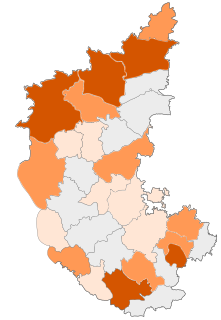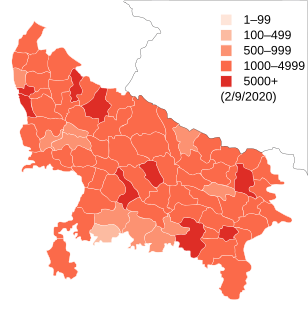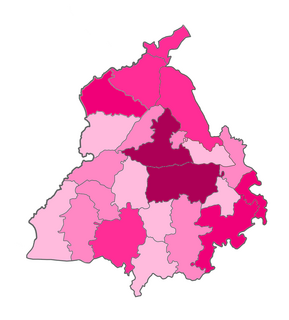Government response
| Major actions (statewide, unless mentioned otherwise) |
|---|
| 9 March | First case confirmed in the state |
|---|
| 13 March | Declaration of epidemic in five cities; Closure of commercial and educational establishments |
|---|
| 14 March | Ban on public gatherings and events |
|---|
| 20 March | Closure of all workplaces barring essential services |
|---|
| 22 March | Imposition of Section 144 and lockdown |
|---|
| 23 March | Curfew and border seal-off in all districts |
|---|
| 25 March | Nationwide lockdown until 14 April |
|---|
| 11 April | Lockdown extended until 30 April |
|---|
| 14 April | Nationwide lockdown until 3 May |
|---|
| 1st May | Nationwide lockdown until 17 May |
|---|
On 13 March, the Government of Maharashtra declared the outbreak an epidemic in the cities of Mumbai, Navi Mumbai, Pune, Pimpri-Chinchwad and Nagpur, and invoked provisions of Epidemic Diseases Act, 1897 which enabled it to forcibly hospitalise anyone with suspected symptoms. Commercial establishments such as movie halls, malls, swimming pools and gyms were shut across the state as a precaution. [77] [78] Chief Minister of Maharashtra, Uddhav Thackeray, issued a ban on all public gatherings and functions. [79] Pune Municipal Corporation decided to close all public gardens and Rajiv Gandhi Zoological Park, effective from 14 March, to contain the spread of the virus. [80]
Thackeray announced that the number of testing labs and their capacities would be increased, as will the capacity of quarantine facilities. [81] On 16 March, the Government of Maharashtra allocated ₹45 crore to the districts with confirmed cases. [82]
After many suspected patients fled from isolation wards of hospitals, the state government directed officials at hospitals and airports to stamp the left hand of people placed under 14-day home quarantine with details of their quarantine period using indelible ink, so as to easily identify them. It also announced that those who violate the quarantine will be isolated at a government facility. [83]
On 17 March, Section 144 was imposed in Nagpur and Nashik. [84]
On 18 March, the Federation of Trade Association of Pune announced that all shops, barring grocery stores and pharmacies, will be shut in the city, resulting in the closure of up to 40,000 shops. [85] Brihanmumbai Municipal Corporation (BMC) announced that shops and commercial establishments across several wards in Mumbai would be closed on alternate days, in order to implement social distancing and crowd management. [86] On 19 March, the dabbawalas in Mumbai suspended their services until 31 March. [87]
On 20 March, Thackeray announced that all workplaces, excluding essential services and public transport, in Mumbai, Mumbai Metropolitan Region, Pune, Pimpri-Chinchwad and Nagpur will be closed until 31 March. He also urged people of the state to not step out of the house without the necessity of doing so. [88]
On 22 March, Thackeray declared that Section 144 would be imposed across the state, with effect from 23 March, sending the state into lockdown. [89] On 23 March, he announced that borders of all the districts will be closed, and a strict curfew will be implemented statewide. [90]
On 26 March, BMC started marking pitches, one metre away from each other, outside grocery stores, fruits and vegetables shops in the city, in order to maintain social distancing. This model was first implemented in Pune on 24 March. [91]
From 1 April, Mumbai Police started using a network of 5,000 CCTV cameras along with drones in order to monitor different parts of the city and ensure that the lockdown is observed. [92] Apart from Mumbai, drones were also used in densely-populated areas of Thane district such as Mumbra and Bhiwandi for aerial surveillance and relaying audio messages and warnings. [93]
On 8 April, Mumbai became the first Indian city to make wearing facemasks in public places compulsory. [94] On the following day, the state government decided to deploy State Reserve Police Force in the city for stricter enforcement of the lockdown. [95]
On 11 April, Thackeray announced that the lockdown in the state will be extended until "at least 30 April". [96] On 14 April, he announced the formation of a COVID-19 Task Force, comprising leading doctors, to advise the state government on means to control the outbreak. [63]
On 17 April, state government decided to relax lockdown restrictions, allowing certain economic activities such as agriculture, construction and manufacturing to resume from 20 April in non-containment zones. [97] However, on 21 April, as the number of cases continued to surge, the government withdrew the relaxation in MMR and Pune. [98]
Containment measures
Several places in the state, where multiple confirmed cases were reported, were sealed off to prevent community spread. These areas included Islampur in Sangli (on 28 March), [99] Worli Kolivada in Mumbai (on 30 March), [100] Peth area and parts of Kondhwa in Pune (on 6 April). [101] By 9 April, BMC identified 381 containment zones within the city; several parts of the city including Dharavi were sealed off as the number of confirmed cases rose sharply in April. [102]
The central government classified the country's districts into zones based on the extent of the spread of virus, with 14 districts in Maharashtra being identified as hotspots and labelled as red zones. [103] The state government announced that it would relax the lockdown restrictions in districts with fewer than 15 confirmed cases. [104]
Impact
Education
Maharashtra government cancelled all the exams from standard 1–8. to make it easier to stop Coronavirus outbreak through schools in students.The students of standard 1st to 8th standard were directly promoted to their next standard [105]
Transport
Over 20,000 bus services of Maharashtra State Road Transport Corporation were cancelled since 11 March, which caused the organisation losses of ₹3 crore by 17 March. [106] Indian Railways cancelled 23 trains from the state in order to prevent the spread of the virus to other states. [107] Government of Gujarat started screening people entering from Mumbai and other borders with Maharashtra by mid of March. The state border was sealed completely during the first lockdown. Since Mumbai started faceing pandemic before Gujarat these precautionary measures were being taken as soon as first lockdown began. Government of Telangana implemented screening of people entering the state of Telangana from Maharashtra at four entry points. [108] Government of Madhya Pradesh suspended all bus services between Indore and Maharashtra until 31 March. [109]
On 22 March, the Indian Railways announced that the Mumbai Suburban Railway will be closed between 22 and 31 March. Mumbai Monorail and Mumbai Metro services were also cancelled until the end of the month. Thackeray announced that state-run and private bus services will be suspended for the general public until further notice. [89] [110]
Economic effects
The virus outbreak had a significant impact on the automobile sector in the state, according to a CNBC TV18 article on 21 March. Bajaj Auto closed down its manufacturing facilities in Akurdi and Chakan until 30 March, while Tata Motors scaled down operations in its Pune plant. Eicher Motors and Ashok Leyland shut down components plant in Thane and Bhandara respectively. Mercedes-Benz suspended operations at its Chakan facility until 31 March. [116] Fiat, Force Motors and JCB also announced suspension of operations at units in Ranjangaon, Akurdi and Chakan respectively, until 31 March. [117] Mahindra & Mahindra also declared that it would suspend manufacturing at its Nagpur plant and production at its Chakan and Kandivali units, starting from 23 March. [118]
According to a 17 March article in the Indian Express, the economy of Mumbai was projected to suffer losses worth at least ₹ 16,000 crore per month in the service sector, as a result of the outbreak. In addition, it predicted that the city's tourism industry would lose ₹ 2,200 crore per month from international tourists. [119]
The entertainment industry in the state also suffered financially, with several Bollywood films postponing release dates or halting production, causing an "acute financial crunch" for many members of the Federation of Western India Cine Employees. [120] Bollywood films were estimated to lose box office revenue of over ₹ 1,300 crore due to the lockdown. [121]
On 30 March, the state government slashed electricity tariff by an average of 8 percent for a period of five years in order to minimize the economic impact of the outbreak on industries. [122] Deputy Chief Minister and Finance Minister, Ajit Pawar, announced that the March salaries of all elected representatives (MLAs, MLCs and Chief Minister) would be cut by 60 percent, while some of the government employees will also see 25 to 50 percent salary cuts due to the economic crisis arising from outbreak and lockdown. [123]
Migrant workers
After the enforcement of lockdown, scores of migrant labourers in Maharashtra who were left without work began to leave for their respective states. [124] Thousands of workers reportedly started going to Gujarat and Rajasthan by foot as transport facilities were suspended, but were stranded at the state border. [125] Thackeray appealed to the migrant workers to not travel back to their states, [126] and announced a ₹ 45 crore package to provide food and accommodation for migrant labourers. [127] On 30 March, the state government set up 262 relief camps across the state, providing food and shelter to 70,339 migrant workers and homeless people. [128] On 8 April, it was reported that 4,653 camps were functioning across the state, which housed more than 550,000 people. These camps were started by district administrations, labour department, irrigation department and cooperative sugar mills. [129] Several employers such as Larsen & Toubro, Godrej Group and Shapoorji Pallonji announced that they would provide food, accommodation and wages to their migrant labourers. [130]
On 14 April, thousands of migrant workers protested against the lockdown near Bandra railway station in Mumbai, and demanded to be sent back to their states. Police made use of baton charges to disperse the unruly crowd and control the situation. [131]





















